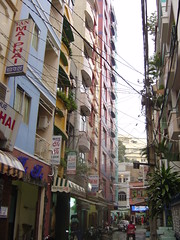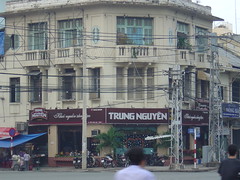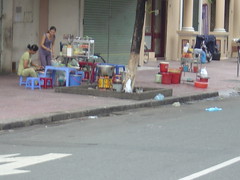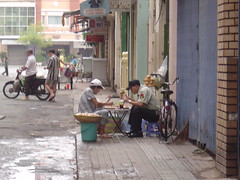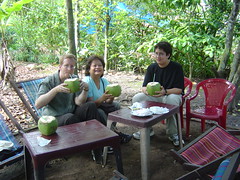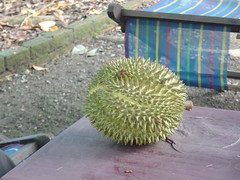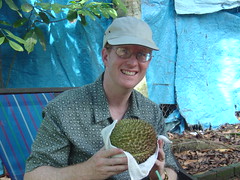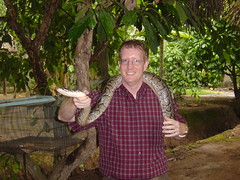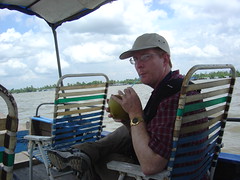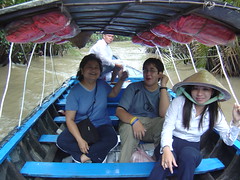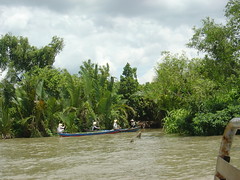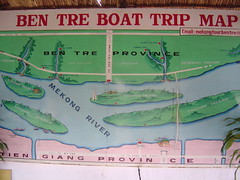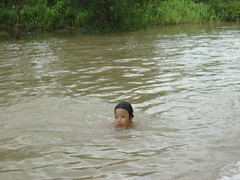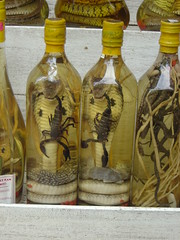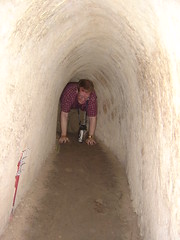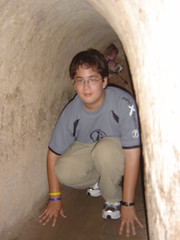Tuesday, June 27, 2006
Traffic in Saigon
Traffic in Vietnam is the typical third world chaos. There seems to be no discernable traffic regulations and many intersections don’t have lights. The most common form of transportation is scooter. Anything that can be balanced on a scooter will be. We saw cages of piglets and chickens, ten foot lengths of rebar, boxed small appliances and entire families on scooters.
If you look carefully at the video, you can see some large parcels on the backs of few scooters. Small children usually stand of the frame of the scooter between the legs of the driver. In the center of the circle were I took this video is a statue and five roads feed into the circle. There are no traffic lights and vehicles from bicycles to buses just merge and weave around each other.
This video was taken in the Cholon section of Saigon near the market. The Cholon district is the city’s Chinatown era and has a long history. In the market, the stalls offer anything and everything at wholesale prices. My wife found a stand selling beaded cell phone ornaments. She bought a couple of dozen at about US$0.50 each. She has seen similar items in the mall for over US$5.00.
Saturday, June 24, 2006
Guest Rooms
We stayed at what are considered luxury hotels while in Vietnam. There are a lot of other lodging options. At the other end of the spectrum are guest houses which are very inexpensive. My mother-in-law stays at these places when she visits for a month or two each year.
A guest house building is a narrow midrise building about five stories high. The ground floor is a lobby with offices. A central stair runs up to each floor. At each floor there are two rooms off of the stair. The room is about 10 feet by 15 feet in size (3m by 5m). The room will have two beds and a small window and an air conditioner as well as other amenities such as phone, a refrigerator and television . There is a bathroom which has a sink, toilet and shower head, but not a separate shower stall.
The rooms cost about ten dollars a day and are very popular with European backpackers. Because of this, they are sometimes called backpacker hotels. Travel agents work in this area offering travel arrangements to outlying cities. These agents offer open bus tickets on frequently traveed routes.
A guest house building is a narrow midrise building about five stories high. The ground floor is a lobby with offices. A central stair runs up to each floor. At each floor there are two rooms off of the stair. The room is about 10 feet by 15 feet in size (3m by 5m). The room will have two beds and a small window and an air conditioner as well as other amenities such as phone, a refrigerator and television . There is a bathroom which has a sink, toilet and shower head, but not a separate shower stall.
The rooms cost about ten dollars a day and are very popular with European backpackers. Because of this, they are sometimes called backpacker hotels. Travel agents work in this area offering travel arrangements to outlying cities. These agents offer open bus tickets on frequently traveed routes.
Tuesday, June 20, 2006
The Starbucks of Vietnam
One of the many capitalist innovations that Vietnam is allowing and adopting is franchising. One of the most common chains is Trung Nguyen, a chain of coffee shops. We saw the brown logo of this brand throughout Vietnam, making it the Starbuck of the country. According to this article, there are over 400 of these shops in Vietnam. High tarriffs keep Starbucks and other chains out.
Since French colonial days, coffee has been an important part of the Vietnamese economy and culture. Vietnamese coffee is a very strong espresso style beverage.
One popular method of serving coffee commonly found in Vietnamese restaurants in the United States is iced coffee with condensed milk. Condensed milk is poured into a glass of ice and then a small pot filled with coffee grounds is placed over the glass. Hot water is poured into the pot and when the coffee is finished seeping into the glass, the coffee, milk and ice are stirred.
In any third world country, tourists are warned not to drink the water. In Vietnam, we stuck to bottled water, but ice is just as dangerous.
One morning I saw a local shop preparing their ice for the day. A large block of ice had been delivered to the shop and one of the workers had set it on the dirty sidewalk and was chipping it with a rusty machete. That sight kept me from drinking any beverages that involved ice. I stuck to refrigerated cans of soda and fruit juice.
Since French colonial days, coffee has been an important part of the Vietnamese economy and culture. Vietnamese coffee is a very strong espresso style beverage.
One popular method of serving coffee commonly found in Vietnamese restaurants in the United States is iced coffee with condensed milk. Condensed milk is poured into a glass of ice and then a small pot filled with coffee grounds is placed over the glass. Hot water is poured into the pot and when the coffee is finished seeping into the glass, the coffee, milk and ice are stirred.
In any third world country, tourists are warned not to drink the water. In Vietnam, we stuck to bottled water, but ice is just as dangerous.
One morning I saw a local shop preparing their ice for the day. A large block of ice had been delivered to the shop and one of the workers had set it on the dirty sidewalk and was chipping it with a rusty machete. That sight kept me from drinking any beverages that involved ice. I stuck to refrigerated cans of soda and fruit juice.
Monday, June 19, 2006
Badminton Saigon Style
In all of Vietnam, lots of people exercise in the morning and badmintion is a very popular game. On one of my morning walks I came across a park near the Ben Thanh Market in Saigon. People were doing everything from tai chi to aerobics to just walking. The group in the video was playing a very competitive game of badminton. Nearby kids and teenagers were just practicing with rackets but no nets.
Monday, May 22, 2006
Breakfast In The Streets Of Saigon
I tend to be an early riser and the rest of my family doesn't. The twelve hour time zone diiference didn't seem to affect that much. Every morning I would wake up about 6 am and take a walk around the city. The morning commute would begin about 7, but before that the breakfast street vendors would set up.
In Saigon, breakfast means small soup stands being set up on the sidewalks. The women in this picture had one of the bigger operations. Breakfast was eaten wherever you wanted or could find a seat, chair or park bench. Pho is the all-purpose meal in Vietnam, serving as a breakfast as well as a lunch or dinner. A propane stove would heat the soup and the herbs that went along it would be set out along the side.
I have no idea if and how the location of the vendors was regulated or decided. There seemed to be a strong element of squatters rights involved, and many of the stand owners probably lived in the building behind their stand. Nevertheless all the food preparation and cooking was done right on the sidewalk. Dirty dishes are placed in a plastic tub of lukewarm soapy water. The overall cleanliness of the set-up discouraged me from ever giving the sidewalks stands a try.
Wherever outdoor dining occured, cheap plastic furniture was never far behind. These brightly colored children-sized stools, tables and chairs would be grouped around for the owners of the satand as well as the patrons. Plastic furniture is very economical and easily replaced if lost or stole. Even large cafes would use plastic lawn chairs for furniture. It tended to give the sidewalks the look of a badly cared for daycare center.
In Saigon, breakfast means small soup stands being set up on the sidewalks. The women in this picture had one of the bigger operations. Breakfast was eaten wherever you wanted or could find a seat, chair or park bench. Pho is the all-purpose meal in Vietnam, serving as a breakfast as well as a lunch or dinner. A propane stove would heat the soup and the herbs that went along it would be set out along the side.
I have no idea if and how the location of the vendors was regulated or decided. There seemed to be a strong element of squatters rights involved, and many of the stand owners probably lived in the building behind their stand. Nevertheless all the food preparation and cooking was done right on the sidewalk. Dirty dishes are placed in a plastic tub of lukewarm soapy water. The overall cleanliness of the set-up discouraged me from ever giving the sidewalks stands a try.
Wherever outdoor dining occured, cheap plastic furniture was never far behind. These brightly colored children-sized stools, tables and chairs would be grouped around for the owners of the satand as well as the patrons. Plastic furniture is very economical and easily replaced if lost or stole. Even large cafes would use plastic lawn chairs for furniture. It tended to give the sidewalks the look of a badly cared for daycare center.
Wednesday, May 17, 2006
Fruit Gardens And Hammock Stands
One of the interesting niche businesses in Vietnam is the fruit garden. These are family run areas of a few acres covered with, obviously, fruit trees. Scattered around the gardens are seating areas tables and canopies. You sit down and they bring you fresh coconut to drink, and then you order plates of fruit to snack on. This was where I finally had my durian.
To get to a fruit garden, you take a small boat down a canal to the garden. The canals are lined with furit gardens and the boat driver takes you to the one he has a relationship with. This particular fruit garden was not particulary good. Most of the chairs were broken and we had to move around a few times. the fruits were slow in coming out. The insects were also starting to get thick by mid-morning.
Industrialization has been rough on this industry. Pollution and haze have impacted the quality of the fruit trees so close to Saigon. Also there are now many more types of recreation vying for the leisure market.
On the main highway to the Mekong Delta, we saw a lot of roadside stands that were a similar type of enterprise. Our guide called them "hammock cafes" for good reason. Each stand would have a grove of trees or a large thatched pavillion with rows of hammocks strung up. the patrons would come by and have refreshments or a meal served and then take a nap in the hammock.
It sounded like agreat idea, but I'm not sure it's a business ready for the go-go western world.
To get to a fruit garden, you take a small boat down a canal to the garden. The canals are lined with furit gardens and the boat driver takes you to the one he has a relationship with. This particular fruit garden was not particulary good. Most of the chairs were broken and we had to move around a few times. the fruits were slow in coming out. The insects were also starting to get thick by mid-morning.
Industrialization has been rough on this industry. Pollution and haze have impacted the quality of the fruit trees so close to Saigon. Also there are now many more types of recreation vying for the leisure market.
On the main highway to the Mekong Delta, we saw a lot of roadside stands that were a similar type of enterprise. Our guide called them "hammock cafes" for good reason. Each stand would have a grove of trees or a large thatched pavillion with rows of hammocks strung up. the patrons would come by and have refreshments or a meal served and then take a nap in the hammock.
It sounded like agreat idea, but I'm not sure it's a business ready for the go-go western world.
Friday, April 28, 2006
Durian Quest
Perhaps one of the most notorious tropical fruits is the durian. Anthony Bourdain in his show Kitchen Confidential went to Vietnam to eat a live beating cobra heart. And a durian. Our guide says the Vietnamese saying about durians are that they "taste like heaven and smell like hell."
The smell is so awful that hotels have rules about guests bringing them to the room. The most common comparison is to dirty diapers.
Durians are actually available in the United States. The Korean run supermarket in my area sells them. Still, I was not leaving Vietnam without eating a durian.
The durian is large with a tough spiky skin. The inside is divided into a series of of compartments each with its own pod. The pod contains a seed and the fruit surrounds the seeds. The fruit is sweet and mushy like over-ripe mango. Personally, I didn't find the taste or the smell as extreme in either direction as hyped. My son whose olafactory sense is probably keener than mine did find the smell a little repulsive.
The meat was very sticky and rather messy to eat. This durian was on the small side and it was still nearly a meal all to itself. I was a little underwhelmed with the experience, but perhaps I had built up the legendary durian just a little too much in my mind.
The smell is so awful that hotels have rules about guests bringing them to the room. The most common comparison is to dirty diapers.
Durians are actually available in the United States. The Korean run supermarket in my area sells them. Still, I was not leaving Vietnam without eating a durian.
The durian is large with a tough spiky skin. The inside is divided into a series of of compartments each with its own pod. The pod contains a seed and the fruit surrounds the seeds. The fruit is sweet and mushy like over-ripe mango. Personally, I didn't find the taste or the smell as extreme in either direction as hyped. My son whose olafactory sense is probably keener than mine did find the smell a little repulsive.
The meat was very sticky and rather messy to eat. This durian was on the small side and it was still nearly a meal all to itself. I was a little underwhelmed with the experience, but perhaps I had built up the legendary durian just a little too much in my mind.
Snake Not On A Plane
While at the honey farm, we had a little time to kill waiting for the rain to die down. They had this big snake in a cage that they let me and my son hold. I think it is some sort of python or other constrictor. My wife wouldn't have anything to do with it.
Eco-tourism is an industry the Mekong Delta area is really hoping catches on. I'm not sure roadside attraction level items like enormous snakes will be enough to keep people coming.
Eco-tourism is an industry the Mekong Delta area is really hoping catches on. I'm not sure roadside attraction level items like enormous snakes will be enough to keep people coming.
Thursday, March 16, 2006
Folk Singers and Tea
Our second stop on our Mekong River boat tour, after we got soaked by rain, was at a honey farm. The didn't actually show any honey production. Instead, the served very delicious honey tea and fresh fruit, which we enjoyed as we dried off.
While we ate and drank, two folk musicians came out and preformed some traditional love songs. The man played some sort of stringed guitar like instrument and the woman sang. We were expected to tip, and we did.
Because of the rain, and also since it was the off-tourist season, we were the only ones there. Another boat did arrive as we were leaving. That caused a minor trafic jam on the very small plank "dock" at the bee farm.
Powered by Castpost
While we ate and drank, two folk musicians came out and preformed some traditional love songs. The man played some sort of stringed guitar like instrument and the woman sang. We were expected to tip, and we did.
Because of the rain, and also since it was the off-tourist season, we were the only ones there. Another boat did arrive as we were leaving. That caused a minor trafic jam on the very small plank "dock" at the bee farm.
Powered by Castpost
Tuesday, March 07, 2006
Up The River
This video is taken from the boat ride up to a coconut candy place. The canal is fairly wide and has tall wood pedestrian bridges over it. The occasional houses along the river are the typical rural wood construction with corrugated metal roofs. The boat ride up to the candy plant took about five minutes and we saw very few houses or other structures. The plants along the bank came right down to the water's edge.
At the candy plant, they demonstrated the traditional method of melting the candy in a large metal kettle and then rolling it and slicing it on a table. The candy is very sweet and chewy, a little like taffy. It is wrapped in an edible cellophane wrapper, which confused my coworkers when I brought some into work after the trip. It was a much bigger hit at the nail salon my wife goes to.
The gift shop was a large thatched roof booth that had a lot of tourist items made out of coconut. We were expected to buy some candy and we did as well as a few souvenir chopsticks carved out of coconut tree. They were very ornately decorated and a good functional souvenir.
Powered by Castpost
At the candy plant, they demonstrated the traditional method of melting the candy in a large metal kettle and then rolling it and slicing it on a table. The candy is very sweet and chewy, a little like taffy. It is wrapped in an edible cellophane wrapper, which confused my coworkers when I brought some into work after the trip. It was a much bigger hit at the nail salon my wife goes to.
The gift shop was a large thatched roof booth that had a lot of tourist items made out of coconut. We were expected to buy some candy and we did as well as a few souvenir chopsticks carved out of coconut tree. They were very ornately decorated and a good functional souvenir.
Powered by Castpost
Tuesday, February 14, 2006
Small Boats and Smaller Boats
The tour boat we crossed the Mekong River on was maybe ten feet (3 meters) wide with moveable patio chairs for seating. We were greeted with coconut drinks as the picture shows. The boat was just a little bigger than one we had ridden on the Perfume River, but then the Mekong River is a bigger river. What it did not have was a small cabin in the back, which would be important later. Our crew consisted of the tour guide and the motor operator.
Our first stop was a ways up a small river tributary to a place where they made honey candy. The stop had working displays of the methods used to make this traditional snack. We bought several packs to give to friends and the Vietnamese nail techs my wife goes to.
On our way to the next stop, while out on the open waters of the main river, we got pounded by a large thunderstorm that sprung up out of nowhere. The flimsy vinyl awning that was the roof of the boat was no cover against the fierce cold driving rain of the storm. The boat driver steered to a mangrove patch on the bank of the river that provided some shelter against the rain, but we were soon soaked to the bone. Meanwhile our tour guide tried to raise the main office on her cellphone to get direction on what to do about the tour.
The rain soon let up enough for us to continue on our way. The next little river branch was too small for our “big boat”, so we transferred to another smaller boat with bench seats that drove us up the river to a fruit garden. This was the heart of darkness part of the trip. The river was very narrow with enormous tropical plants coming up right to the river edge. I imagined us being in Apocalypse Now going up river to find Colonel Kurtz. We ended up at a fruit garden where we could rest under shelter and dry of instead. A much more pleasant destination.
Elsewhere on the river we saw some boats no bigger than canoes painted in the same color as the other tour boats. I think the tour got cut short a little bit by the rain storm, but I imagine that these smaller boats are also used to take tourists up even smaller creeks. We were expected to tip the driver of both boats as well as the guide, so missing out on the last boat ride proboably saved us just a little money as well.
Our first stop was a ways up a small river tributary to a place where they made honey candy. The stop had working displays of the methods used to make this traditional snack. We bought several packs to give to friends and the Vietnamese nail techs my wife goes to.
On our way to the next stop, while out on the open waters of the main river, we got pounded by a large thunderstorm that sprung up out of nowhere. The flimsy vinyl awning that was the roof of the boat was no cover against the fierce cold driving rain of the storm. The boat driver steered to a mangrove patch on the bank of the river that provided some shelter against the rain, but we were soon soaked to the bone. Meanwhile our tour guide tried to raise the main office on her cellphone to get direction on what to do about the tour.
The rain soon let up enough for us to continue on our way. The next little river branch was too small for our “big boat”, so we transferred to another smaller boat with bench seats that drove us up the river to a fruit garden. This was the heart of darkness part of the trip. The river was very narrow with enormous tropical plants coming up right to the river edge. I imagined us being in Apocalypse Now going up river to find Colonel Kurtz. We ended up at a fruit garden where we could rest under shelter and dry of instead. A much more pleasant destination.
Elsewhere on the river we saw some boats no bigger than canoes painted in the same color as the other tour boats. I think the tour got cut short a little bit by the rain storm, but I imagine that these smaller boats are also used to take tourists up even smaller creeks. We were expected to tip the driver of both boats as well as the guide, so missing out on the last boat ride proboably saved us just a little money as well.
Monday, February 06, 2006
Across The River
Between My Tho and Ben Tre, there are four islands in the middle of the Mekong River. The islands are named after the four sacred animals of Vietnam, the dragon, phoenix, unicorn, and turtle. The boat tour goes between the islands to get to the Ben Tre side of the river. The islands are heavily planted with small villages along the water’s edge.
On the phoenix island, Phung Island, there are the ruins of a complex built by an eccentric holyman named called the Coconut Monk because he subsisted solely on coconuts. The grotto was built in the 1960s and looks like an abandoned amusement park. Right on the edge of the water is a large steel Buck Rogers looking space ship.
The pass between the islands is very busy as all the river traffic goes through it. Large ferry boats are the primary way across the river. A very large modern concrete bridge is under construction that will connect My Tho to Ben Tre. When finished it will open up the Delta area to considerably more traffic from the Saigon area.
On the phoenix island, Phung Island, there are the ruins of a complex built by an eccentric holyman named called the Coconut Monk because he subsisted solely on coconuts. The grotto was built in the 1960s and looks like an abandoned amusement park. Right on the edge of the water is a large steel Buck Rogers looking space ship.
The pass between the islands is very busy as all the river traffic goes through it. Large ferry boats are the primary way across the river. A very large modern concrete bridge is under construction that will connect My Tho to Ben Tre. When finished it will open up the Delta area to considerably more traffic from the Saigon area.
Sunday, January 29, 2006
Swimming In The Mekong
The Mekong River is the economic heart of Vietnam. The river starts in the Himalayas and winds it way through all of south-east Asia before entering the South China Sea. Nine tributaries branch off the river and form the Mekong Delta. My Tho is the town on the river closest to Saigon.
Eco-tourism has become a huge component of the economy in the area. At least two enormous open-air restaurants cater to the tour bus industry. The multi-course meal here features as its center piece a locally farm raised fish that is grilled and served at the table “standing” upright.
Tour boats operate from the river front and take tourists to a variety of local native craft exhibits strung along the river. The river itself is a huge wide muddy super-highway with ferries, sand dredging barges, tour boats and fisherman all trying to run each other over. The boats come in all sizes and shapes. Most boats have some sort of stylized dragon on the bow to scare away the crocodiles that traditionally ply the river.
Much to our amazement, considering the ochre color of the water, small children swim and play right in the river. The level of biological contamination in this country with a still developing sanitary infrastructure would scare away most first world swimmers.
Still, children are children and there is nothing more refreshing than a dip into a dirty crocodile infested river to cool off on a hot day.
Eco-tourism has become a huge component of the economy in the area. At least two enormous open-air restaurants cater to the tour bus industry. The multi-course meal here features as its center piece a locally farm raised fish that is grilled and served at the table “standing” upright.
Tour boats operate from the river front and take tourists to a variety of local native craft exhibits strung along the river. The river itself is a huge wide muddy super-highway with ferries, sand dredging barges, tour boats and fisherman all trying to run each other over. The boats come in all sizes and shapes. Most boats have some sort of stylized dragon on the bow to scare away the crocodiles that traditionally ply the river.
Much to our amazement, considering the ochre color of the water, small children swim and play right in the river. The level of biological contamination in this country with a still developing sanitary infrastructure would scare away most first world swimmers.
Still, children are children and there is nothing more refreshing than a dip into a dirty crocodile infested river to cool off on a hot day.
Friday, January 20, 2006
Making Rice Paper
Not all the exhibits at the Cu Chi tunnels deal with the war. One display shows the traditional method of making rice paper. Rice paper is used as the wrapper for the Vietnamese version of the egg roll, called cha gio. The rice past is put on a small crepe pan style burner and then set on a bamboo screen to cool. This way the rice paper can stay fresh for several days without spoiling.
The exhibit also included a still making rice wine. Wine is a misnomer since it is at least 80 proof.
Across the way from this exhibit is a firing range where visitors can shoot AK-47's. It is the only legal firing range in Vietnam.
Powered by Castpost
The exhibit also included a still making rice wine. Wine is a misnomer since it is at least 80 proof.
Across the way from this exhibit is a firing range where visitors can shoot AK-47's. It is the only legal firing range in Vietnam.
Powered by Castpost
Tuesday, January 10, 2006
Visit The Cu Chi Gift Shop
One aspect of modern capitalist society that the Vietnamese Army has successfully emulated is the tourist attraction gift shop. As the Cu Chi tour ends, there is a long row of open air stalls selling souvenirs. The items for sale include all sorts of gear with the yellow star and red background, just in case you forgot who won the war. The tire tread sandals were tempting, although I’m sure they are no longer getting the tires from destroyed US trucks.
A large number of items appealed to the sense of machismo, like the cobra and scorpion liquor. Our guide mentioned to drink it while still in Vietnam if we wanted some because the chance of getting it through customs might be slim. They did offer free samples and it made Italian grappa and Kentucky moonshine taste smooth in comparison.
There was also a large (12 foot or longer) stuffed crocodile that you could pose with. You could get your picture either with or without the company of the very attractive lady in native garb at the booth. I kept getting a mental image of large groups of Japanese or Chinese businessmen on vacation trying to pass off the croc as something they killed while on safari.
I think the Communists may have won the war, but good old fashion marketing is winning the hearts and minds.
A large number of items appealed to the sense of machismo, like the cobra and scorpion liquor. Our guide mentioned to drink it while still in Vietnam if we wanted some because the chance of getting it through customs might be slim. They did offer free samples and it made Italian grappa and Kentucky moonshine taste smooth in comparison.
There was also a large (12 foot or longer) stuffed crocodile that you could pose with. You could get your picture either with or without the company of the very attractive lady in native garb at the booth. I kept getting a mental image of large groups of Japanese or Chinese businessmen on vacation trying to pass off the croc as something they killed while on safari.
I think the Communists may have won the war, but good old fashion marketing is winning the hearts and minds.
Tuesday, January 03, 2006
Into The Tunnels
The premiere attraction of the Cu Chi Tunnel area is of course to go into the tunnels. After touring all the dioramas and displays, visitors are given the opportunity to crawl through a 100 meter long segment of the actual tunnels. Ironically, these particular tunnels have been widened to accommodate the larger frames of western tourists, which was one of the virtues of the original small tunnels.
No one is obligated to go through the tunnels and my wife declined. My son and I were game. The particular stretch of tunnel used for tourists has exit points at the 10 meter and 25 meter marks for those that do get too claustrophobic. We made the whole distance. The tunnel is too tall to walk upright in leaving the options of either crawling on hands and knees or duckwalking through.
I crawled carrying my camcorder, giving me about 10 minutes of footage that consists of flashes from the Army guide up ahead taking our picture and the sounds of us huff and puffing our way through. The tunnel was very hot and just as humid as the outdoors, causing a lot of perspiration that turns the dry ground of the tunnel into mud when mixed. All in all, not an unpleasant experience, but not one I’m eager to repeat.
There is a convenient hand-washing station at the end of the tunnel for washing off the dust and mud.
No one is obligated to go through the tunnels and my wife declined. My son and I were game. The particular stretch of tunnel used for tourists has exit points at the 10 meter and 25 meter marks for those that do get too claustrophobic. We made the whole distance. The tunnel is too tall to walk upright in leaving the options of either crawling on hands and knees or duckwalking through.
I crawled carrying my camcorder, giving me about 10 minutes of footage that consists of flashes from the Army guide up ahead taking our picture and the sounds of us huff and puffing our way through. The tunnel was very hot and just as humid as the outdoors, causing a lot of perspiration that turns the dry ground of the tunnel into mud when mixed. All in all, not an unpleasant experience, but not one I’m eager to repeat.
There is a convenient hand-washing station at the end of the tunnel for washing off the dust and mud.
Subscribe to:
Posts (Atom)
